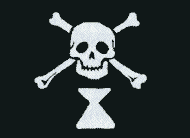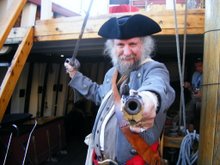Darkness
Last year Mythbusters did a special pirates episode. One of the myths they explored was that pirates wore a patch over a perfectly good eye so that they could remove it and see in the dark. They tried it and it worked so they classified it as plausible.
Presumably a pirate would do this in anticipation of taking a ship and having to do a hurried search of the hold. There is a gaping flaw in this theory - no one in his right mind would cover an eye before going into battle.
Navigation
The Pirate Master site says this:
Another theory: the eye patch stereotype predates the "Golden Age of Piracy" by some 200 years. Up until the 1500s one of the key tools of maritime navigation was the cross staff, which required the navigator to look directly into the sun at high noon. This led to a lot of sailor/navigators who were partially blind in one eye. After significant sight loss, many would likely have taken to wearing an eyepatch over the afflicted eye. By the 1500s other tools like the back staff had been invented which eliminated the need to look directly into the sun, but by then the sailor/eyepatch image had snuck into public consciousness.There are lots of problems with this one. First, it gets the dates wrong. While the cross staff was invented around 1300, it was not used for navigation until after 1500.
More important, looking at the sun does not make you lose an eye. If you look long enough it causes blind spots. even with multiple blind spots, there would be no need to wear an eye patch.
Most important, this would only affect navigators and it would affect all navigators equally regardless of any association with piracy.
Unlike many things that we think of as "pirate", eye patches are not associated with sailors, just pirates. This makes this a very unlikely reason for wearing an eye patch.
History
There can be no doubt that piracy was dangerous. All of the surviving articles that pirates sailed under list cash sums to be paid to anyone who loses an arm, leg, or eye. There was good reason for this. Since pirates tended to attack any ships they came across, they might see more fighting than any other sailors, even members of a navy.
While some pirates undoubtedly lost an eye, this does not seem to be how they were perceived. When researching this posting, I looked over most of the period pictures of pirates. I couldn't find any with an eye patch.
Hollywood.
The root of all pirate legends, Hollywood seems to have invented the image of a pirate wearing an eye patch in the 20th century. This site indicates that it came from the 1950 Treasure Island along with talking like a pirate and nearly everything else pirate-like.
Probably the people doing the research saw the same articles I mentioned above and over-represented pirates in eye patches.
I am still researching this but one strong indication is the lack of pirates (real and fictional) under Wikipedia's list of eye patch wearers.
So - bottom line, some pirates definitely lost an eye but not enough to influence the image of pirates until it was defined by Hollywood in the 20th century.
A pirate who wants to wear an eye patch is on solid historic ground but he should be in the minority and he should represent it as an eye lost in battle.



